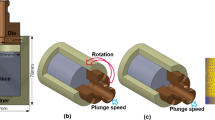Abstract
The strong thermo-mechanical stress is one of the most critical failure mechanisms that affect the durability of thermoelectric devices. In this study, numerical simulations on the formation mechanism of the maximum thermal stress inside the thermoelectric device have been performed by using finite element method. The influences of the material properties and the thermal radiation on the thermal stress have been examined. The results indicate that the maximum thermal stress was located at the contact position between the two materials and occurred due to differential thermal expansions and displacement constraints of the materials. The difference in the calculated thermal stress value between the constant and the variable material properties was between 3% and 4%. At a heat flux of 1 W·cm-2 and an emissivity of 0.5, the influence of the radiation heat transfer on the thermal stress was only about 5%; however, when the heat flux was 20 W·cm-2 and the emissivity was 0.7, the influence of the radiation heat transfer was more than 30%.
Similar content being viewed by others
References
Bell L E. Cooling, heating, generating power, and recovering waste heat with thermoelectric systems. Science, 2008, 321(5895): 1457–1461.
Guo R, Huang B. Thermal transport in nanoporous Si: Anisotropy and junction effects. International Journal of Heat & Mass Transfer, 2014, 77(10): 131–139.
Shen L, Chen H, Xiao F, et al. The step-change cooling performance of miniature thermoelectric module for pulse laser. Energy Conversion & Management, 2014, 80(4): 39–45.
Ur SC, Kim IH, Nash P. Thermoelectric properties of Zn4Sb3 directly synthesized by hot pressing. Materials Letters, 2004, 58(15): 2132–2136.
Rao A M, Ji X, Tritt T M. Properties of nanostructured one-dimensional and composite thermoelectric materials. MRS Bulletin, 2006, 31(3): 218–223.
Poudel B, Hao Q, Ma Y, et al. High-thermoelectric performance of nanostructured bismuth antimony telluride ulk alloys. Science, 2008, 320(5876): 634–638.
Venkatasubramanian R, Siivola E, Colpitts T, et al. Thinfilm thermoelectric devices with high room-temperature figures of merit. Nature, 2001, 413(6856): 597–602.
Zhao X B, Ji X H, Zhang Y H, et al. Bismuth telluride nanotubes and the effects on the thermoelectric properties of nanotube-containing nanocomposites. Applied Physics Letters, 2005, 86(6): 062111.
Sharma S, Pandey S K. A first principle study of electronic band structures and effective mass tensors of thermoelectric materials: PbTe, Mg2Si, FeGa3 and CoSb3. Computational Materials Science, 2014, 85(4): 340–346.
Sharp J W, Jones E C, Williams R K, et al. Thermoelectric properties of CoSb3 and related alloys. Journal of Applied Physics, 1995, 78(2): 1013–1018.
Sandozrosado E J. Investigation and development of advanced models of thermoelectric generators for power generation applications. IEEE Journal of Selected Topics in Applied Earth Observations & Remote Sensing, 2009, 4(2): 318–326.
Zhou Z G, Zhu D S, Wu H X, et al. Modeling, experimental study on the heat transfer characteristics of thermoelectric generator. Journal of Thermal Science, 2013, 22(1): 48–54.
Wu Y, Ming T, Li X, et al. Numerical simulations on the temperature gradient and thermal stress of a thermoelectric power generator. Energy Conversion & Management, 2014, 88(88): 915–927.
Ming T, Wu Y, Peng C, et al. Thermal analysis on a segmented thermoelectric generator. Energy, 2015, 80: 388–399.
Ming T, Yang W, Wu Y, et al. Numerical analysis on the thermal behavior of a segmented thermoelectric generator. International Journal of Hydrogen Energy, 2017, 42(5): 3521–3535.
Hsu C T, Huang G Y, Chu H S, et al. Experiments and simulations on low-temperature waste heat harvesting system by thermoelectric power generators. Applied Energy, 2011, 88(4): 1291–1297.
Heremans J P, Thrush C M, Morelli D T. Thermopower enhancement in lead telluride nanostructures. Physical Review B, 2015, 70(11): 2516–2528.
Eck M, Uhlig R, Mertins M, et al. Thermal load of direct steam-generating absorber tubes with large diameter in horizontal linear fresnel collectors. Heat Transfer Engineering, 2007, 28(1): 42–48.
Rhyee J S, Lee K H, Sang M L, et al. Peierls distortion as a route to high thermoelectric performance in In4Se3-δ crystals. Nature, 2009, 459(7249): 965–968.
Rajendran D R, Sundaram E G, Jawahar P. Experimental studies on the thermal performance of a parabolic dish solar receiver with the heat transfer fluids SiC+water nano fluid and water. Journal of Thermal Science, 2017, 26(3): 263–272.
Cheng J, Park S, Chen C L. Optofluidic solar concentrators using electrowetting tracking: Concept, design, and characterization. Solar Energy, 2013, 89(2): 152–161.
An Z, Jia L, Ding Y, et al. A review on lithium-ion power battery thermal management technologies and thermal safety. Journal of Thermal Science, 2017, 26(5): 391–412.
Ming T, Wang Q, Peng K, et al. The influence of nonuniform high heat flux on thermal stress of thermoelectric power generator. Energies, 2015, 8(11): 12584–12602.
Ming T, Pan T, Wang Q, et al. Influence of non-uniform heat flux on performance of thermoelectric device. CIESC Journal, 2016, 67(5): 1798–1805.
Author information
Authors and Affiliations
Corresponding author
Additional information
This study is financially supported by the Science Challenge Project (Grant No. TZ2018003)
Rights and permissions
About this article
Cite this article
Pan, T., Gong, T., Yang, W. et al. Numerical Study on the Thermal Stress and its Formation Mechanism of a Thermoelectric Device. J. Therm. Sci. 27, 249–258 (2018). https://doi.org/10.1007/s11630-018-1006-3
Received:
Published:
Issue Date:
DOI: https://doi.org/10.1007/s11630-018-1006-3




